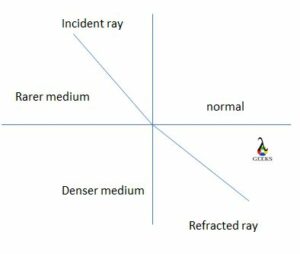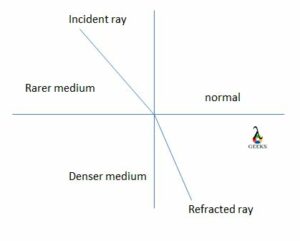Does refraction change speed? Certainly, the refraction will change speed when travelling from one medium to another.
How to know does refraction changes speed? When light travels from a rarer medium to a denser medium, the speed will change and certainly will know if the refraction ray moves towards or away from the normal.
To understand this phenomenon better, we shall use a real-world example and apply the same notions here. A cart with wheels on all its edges is kept on a concrete road. What will happen if this cart is moved to the grass area when constant force is applied to it?
When the cart is moved to the grass, the speed will increase and move in the same direction, but only if the original direction seems to be perpendicular. Otherwise, the speed may vary according to the respective direction.
Now the cart is moved from the concrete road to the grass area at an angle. We might see a change in the direction of the cart. The wheel entering the grass surface will slow down, causing the other wheel to enter the grass area too. So altogether, the wheel will move towards the right.
Now that the cart’s front wheels have different speeds compared to the ones on the concrete road. With constant speed, the cart will move in the same direction as the front wheels. This is similar to light waves in a different medium.
How does refraction change speed?
The explanation in the above section regarding the topic of refraction change speed, with the example, has given an initial viewpoint on the changing speeds in different mediums.
Now we need to deal with the following question of how does refraction change speed. Using the same example as earlier, we shall see how the process goes. When a cart is moved from the concrete road into the grass area, the speed of the cart is changed.
Similar is the case with the refraction of light if it moves from a rarer to denser medium and forms a denser to rarer medium. The refraction direction is determined when it moves towards the normal or away from the normal.
Like when we said that the wheels of the cart would lower its speed when it enters the grass area; similarly, the refraction speed will decrease when it leaves the rarer medium and enters the denser medium.
The next case is that when the cart moves from the grass area to the concrete road, the wheel will undoubtedly change its speed and move from the normal that is imaginably drawn on the surface.
Similarly, the refraction will change its speed when it enters the rarer medium after leaving the denser medium. Here also, the speed will decrease sin it is changing its direction from the original direction, that is, when it moves away from the normal to the surface.
Why does refraction change speed?
Certain factors change the speed of light in terms of refraction. Let us use the same example as earlier and understand this better.
For instance, the cart moving from the concrete road to the grass area experiences a change in speed and direction. So why does the refraction speed change? The reason is that resistance is applied to the cart’s wheels when it enters the grass area.
The grass area offers more resistance than the concrete road, so when the first wheel of the cart touches the grass due to resistance, the speed will be altered, causing the rest of the wheels to change speed.
Similarly, when the ray of light enters the denser medium from the rarer medium, the speed of refraction will change, changing the speed as well. The reason being the refractive index is different for a different medium.
The refraction changes its speed because once the light enters another medium, it will change the speed according to the medium it travels. So it will end up having a wavelength either shorter or longer based on the medium and the change in velocity.
The refractive index plays a vital role as it aids in changing the direction and the speed of the light wave. Depending on which the index will increase or decrease the speed of the light wave.

When does refraction change speed?
The word refraction itself means a change in the direction of the light wave entering one medium from another.
When the light wave enters the denser medium from the rarer medium, the first set of beams touching the denser medium will instantly change the speed. That is, the speed of the beam will decrease.
It will cause the rest of the beam to change its speed accordingly when it is entirely in the denser medium now. The surface of the medium plays a significant part in altering the speed and direction of the light wave entering.
Also, if the light beam travels in the direction perpendicular to it, the speed will increase and keep moving in the same direction as the original one. The medium in which the light travels will aid in altering the quantity, such as velocity and wavelength.
Similarly, when the light wave travels from a denser medium to the rarer medium, the speed will increase and move away from the surface’s normal. So the medium is essential for the light to travel.
If the light beam is incident the denser medium, it will move towards the normal as the speed of the beam is decreased, and when the light beam is incident on the rarer medium, the speed will increase and bend away from the normal.

Relationship between Speed and Refraction
Light waves been when it travels from one medium to another , and speed is the measure of how much it has been bent.
Refraction itself means the change of direction due to the change in speed of the light wave entering one medium from another medium. We can easily understand the concept using Snell’s Law n1/n2 = sin α2/sin α1, which gives an idea.
Snell’s Law is the Law that describes the relationship between the incident angle and the refracted angle of the light wave passing from one medium to another. From this, we can easily capture the relation between refraction and speed.
Refraction refers to the process when a light wave bends towards or away from the normal. When this happens, depending upon the medium, the light’s speed is described, and hence the speed and refraction are required to determine the direction of the light wave.
The change in the direction of the light wave is determined by the amount of change in speed of that light wave that enters a particular medium. Early attempts were made to study the speed of light when it travels from one medium to another.
Problems on how does refraction changes speed
There is one formula to solve any problem regarding refraction, reflection, speed and direction of any light wave entering and leaving a medium.
So here, in this case, we use the formula of Snell’s Law, which will help determine the refraction, speed, and direction. Mainly as to how does reflection changes speed.
Problem 1:
Calculate the speed of light in water when it enters the medium from the air (rarer medium). The speed of light in air is 3×108, and the refractive index of the denser medium is 1.333.
Solution:
We know the relation between the speed of light in a medium and the refraction is n=c/v. We are rearranging this formula to get velocity, v=c/n.
V=c/n
V=3×108/1.333
V=2.2505 x 108 m/s
The speed of light in the denser medium seems to be larger than half of the speed in a vacuum.
Problem 2:
Calculate the speed of light in acetone when it enters the medium from the air (rarer medium). The speed of light in air is 3×108, and the refractive index of the denser medium is 1.36.
Solution:
V=c/n
V=3×108/1.36
V=2.2058 x 108 m/s
The speed of light in the denser medium also decreases when it enters from the rarer medium.
Frequently Asked Questions
Why does refraction occur in water?
Refraction occurs in water because the refractive index of water is higher than in a rarer medium.
When a light beam travels from rarer and touches the denser medium, it will instantly change direction. The reason is that air is a rarer medium and water is a denser medium, which is determined by the refractive index of both mediums, respectively. Since the water is denser than air, the light wave will bend towards the normal, called refraction.
Why does light refract when it enters a different medium?
The light reflects when it enters another medium is because the refractive index of all mediums has different values.
This is also regarded as refraction. This occurs because when the light beam enters the medium and changes the speed, it changes its direction as well. In this way, we can see that if the light beam is perpendicular to the surface, there will be no change in the direction but only the speed changes.
Will the light beam bend when entering different mediums if the speed of light is constant in all mediums?
Certainly no, the light beam bends when entering a different medium only when the speed of light is different in a different medium.
If the speed of light is a constant in all mediums, there will be no bending of light waves happening. The light wave will experience a change in speed when it enters a different medium due to the value of the speed of light. The difference in speed between the two mediums is why there is a ripple on the water when the light travels from the medium of air to water.
What will happen if a light wave travels from a rarer medium to a medium with a negative refractive index?
Firstly we need to know the maturity of light, whether it is a particle or a wave.
The magnitude value of velocity is regarded to be the speed. Speed cannot be negative, and when we consider the velocity, it certainly cannot be negative. The answer to this question is mainly practicality. If the light is a wave, then depending upon the light’s phase velocity, we must conclude. Refractive index is a ratio of two quantities there is no question for it to be positive or negative.
Also Read:
Hi…I am Keerthana Srikumar, currently pursuing Ph.D. in Physics and my area of specialization is nano-science. I completed my Bachelor’s and Master’s from Stella Maris College and Loyola College respectively. I have a keen interest in exploring my research skills and also have the ability to explain Physics topics in a simpler manner. Apart from academics I love to spend my time in music and reading books.
Let’s connect through LinkedIn